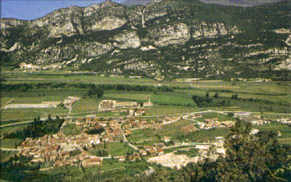The town of Dolce’ Verona province extends along the left bank of the Adige river.
This village, already known as “Dolcetum”, boasts in its surroundings some interesting archaeological finds of the prehistoric era. The historical centre of Dolce’ rises around three beautiful mansions, the Ruzzenenti-Fasanotto palace, the Guerrieri-Rizzardi palace and the Salgari palace, that is currently the premises of the town hall. A landmark of the town is the fort, built by the Austrians, that overlooks the town and takes its name from the suburb nearby; the ancient brewery “Alla Grotta” (the cave), a famous location for over two centuries for the breath of air that comes from the bowels of the earth and cools the cellars where the beer is kept. Beyond Dolce’ lies Volargne, the main centre and economic centre of the municipal territory. Noteworthy here are a post stage that was used to provide refreshment to the wayfarers and the horses, at the time when journeys were done by carriage; and some mansions, among which Villa Del Bene is certainly the most beautiful. Further on lies Peri, an area of extreme importance, because here is the only bridge on the watercourse in the Veronese part of the Adige Valley, which allows people to cross from one bank to the other. In Peri, too, many witnesses of a thriving historical past were found, with the discovery of prehistoric and Roman findings. Lastly, there is Ossenigo, a village known since 928, when it was quoted in an ancient medieval document. Here, between the Middle Ages and the modern era, were a customs house, a leper colony, a caravanserai for the change of horses and a hospital for the care of the wayfarers. The village is overlooked by the Romanic church of Saint Andrew.

TERRITORY OF DOLCE’ VERONA
Province: Verona
Fractions: Ceraino, Ossenigo, Peri, Volargne
Surrounding municipalities: Avio (Tn), Brentino Belluno, Fumane, Rivoli Veronese, Sant’Ambrogio di Valpolicella, Sant’Anna d’Alfaedo
Altitude: 115 m s.l.m. – Inhabitants name: dolceati
Fractions: Ceraino, Ossenigo, Peri, Volargne
Surrounding municipalities: Avio (Tn), Brentino Belluno, Fumane, Rivoli Veronese, Sant’Ambrogio di Valpolicella, Sant’Anna d’Alfaedo
Altitude: 115 m s.l.m. – Inhabitants name: dolceati
The City of Dolce’ is located along the course of the Adige river from which it lapped across its western border. Located about 27 km from the capital to Ossenigo until 1915 was the border with the Austro-Hungarian Empire. It has about 2,444 inhabitants and four hamlets. The most populous country is Volargne but for various historical and geographical reasons, the municipality located in Dolcè. Today campaigns around Dolcè have adapted to intensive culture of the vine.
HISTORY OF DOLCE’ VERONA
In the countryside of Dolce’ have been brought to light interesting archaeological finds of the prehistoric era. Surely the most important is the safety Soman Upper Paleolithic. In the valley of Arusnati is likely a settlement of Roman and pre-Roman and medieval era can be seen as evidence Casteleto. Famous in the center of the three palaces of great beauty: Ruzzenenti-Fasanotto, the Guerrieri-Rizzardi and the Salgari, now city hall. In 1800 he was greatly fortified by the Austrians to protect its border with the Italian territory. Among Ceraino and Volargne they put the fort of Chiusa while Fort Ceraino on the side of the mount Pastello. You can still see all these fortifications although in a state of disrepair. Ceraino was destroyed by an explosion following a bombing of a German train loaded with ammunition and weapons during the Second World War.
